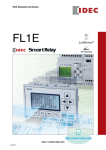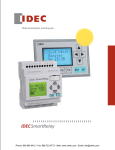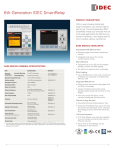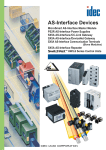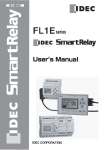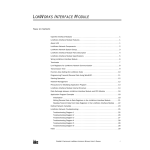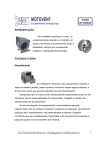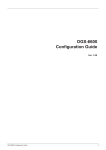Download FL1D - Idec
Transcript
Think Automation and beyond...
FL1D
LONWORKS®
AS-Interface
http://smart.idec.com
FL1D SmartRelay
NPN/PNP Sensor Input
Digital/Analog Inputs
Output from NPN/PNP sensors
can be loaded without external
resistance. This enables wider
selection of input devices and
saves wiring time.
(Available on FL1D-H12RCA,
FL1D-B12RCA, and FL1BM08D2R2)
6 digital plus 2 digital or analog.
Multiple inputs provide direct
communication with pushbuttons, sensors, switches, etc. (2
kHz max. on I5 and I6)
(Digital and analog compatible
inputs: I7 and I8 on FL1DH12RCE, FL1D-B12RCE, and
FL1D-H12SND)
LED Display Panel
with Backlight
Contrast Function
Interfaces for Easy
System Changeover
A memory cartridge to
copy user programs and
the communication cable
for WindLGC can be
installed/removed easily,
allowing easy system
changeover.
Display up to 48 characters of message. Monitor
any of the 8 basic or 28
special function blocks,
or confirm the status of
the parameters.
Digital Output
Control Buttons
Use the outputs to control
lights, small motors, and
solenoid valves up to 10A.
Easy programming using 6
buttons. No tools necessary
for changing parameters even
after mounted on a panel.
Major Features
The FL1D SmartRelay contains
various functions such as timer,
counter, and calender. No more
complicated wiring is required.
Just use the buttons and the
LCD panel to write programs.
System changeover that
requires parameter changes is
easy too.
Programming software
WindLGC is available for easy
programming. Save your user
program, and print it out as a
document. Simulation functions
make it easy to edit programs
and set parameters while confirming on the screen.
FL1D Analog Output Module
New Function Blocks: 3 Types
A new system solution can be realized
by combining the FL1D with analog output modules.
Used in wide range of applications such
as simple flow control, conveyor control,
and air-conditioning control.
By using function blocks integrated with
calculation functions, programming is
possible using analog values.
Page 4,5
WindLGC V.5
Programming software for the FL1D is
upgraded to WindLGC V.5.
WindLGC is upgraded
not only for easier programming but also for
more convenience in
maintenance work.
Download
Demo Version
http://www.idec.com/english/download/
2
• PI Control
Page 4
• Analog Ramp Function
• Analog Multiplexer
Page 4
Page 5
Upward Compatible
User Program
User programs for preceding FL1A,
FL1B, and FL1C IDEC SmartRelays can
be imported to the FL1D using
WindLGC V.5.
Expansion Modules
Expansion modules allow you to add
FL1B I/O modules and communication
modules.
(Note: New FL1D analog output module
can only be combined with FL1D base
modules.)
Flexible, Versatile,
User-Friendly
Quality features packed in a compact-sized body
The IDEC SmartRelay with a full line of analog output modules
meet user demands for versatile and flexible use
Concept
Reduce the wiring
to a minimum.
Control multiple devices
in a simple set up.
S
elay
artR luti
m
S
S art o on
m
And, save the cost.
Replaces relays, timers,
and counters
Smaller system than
using a PLC
Reduces your workload
Text
Display
Sensor
PLC
Cou
nte
r
Relay Te rminal
Ana
Motor
log
Tim
er
Solenoid Valve
Change your complicated system of multiple relays, timers,
and counters to a single IDEC
SmartRelay.
Easy Maintenance
LCD display panel and control buttons enable easy
monitoring of digital/analog input and output functions,
parameter display of timer functions, and parameter
changes.
Also, by using message output functions, error messages can be displayed.
The IDEC SmartRelay
replaces many functions of
peripheral equipment of the
programmable logic controller.
Features 10A max. output contacts and up to 48 characters
of display.
Rela
y
36 different types of function
blocks make it possible to perform various control operations
easily.
Program Size: 2,000 Byte
• Programmable bytes: 2,000 maximum
• Programmable blocks: 130 maximum
Internal relay (Memory marker)
Message display (Message Text)
Timers
Relays
24 maximum
10 maximum
Unlimited ∗
Unlimited ∗
∗ within the programmable bytes
Memory Cartridge
FL1C-PM3 memory cartridge protects your programs
from unintended modification, copying or deletion.
User programs can be easily copied to multiple IDEC
SmartRelays.
Economical Type
Economical types without display and control buttons
are also available.
3
Smart Solution for Smart Engineers!
The SmartRelay is useful for machines with analog functions
A/M
R
PV
Par
Q
PI Control
Application Example: Industrial Fryer
Menu
Feedback control by combining proportional
and integral control actions.
When all the ingredients are added in the oil tank, the oil
temperature falls temporarily but automatically goes back to
the set temperature by the PI function.
The fryer should be designed so that the oil temperature
does not exceed 250°C or fall below 80°C.
• Analog Output Timing Chart
Food A…160°C
Food B…180°C
Food C…200 °C
Food D…220 °C
AM
R
/–
/+
Dir
250
Oil temperature must be
between 80 °C and 250 °C
Menu (A, B, C, D)
80
Max
PV
SP
Min
Mq
PI Control
Function Block
Other application examples:
Simple feedback control such as pressure, flow, and
liquid surface detection
En
Sel
St
Par
Q
Analog Ramp Function
Application example: Automatic door
Reset (AQ stop)
Oil returns to set temperature
(PI Recovery Operation)
AQ
Oil rises to set temperature
(PI Recovery Operation)
A/M
R
PV
Par
Add Ingredients (Oil temperature
falls due to disturbance)
Analog Multiplexer
Function Block
+
Start Cooking (Control Mode ON)
(Program Image)
AQ
Switch On Fryer
En
S1
S2
Par
Upper oil temperature limit
Lower limit adjustment
AQ
500 ms
Q
Menu
Temperature Settings
Analog value outputs can be changed for the
2 selected levels.
The automatic door closes in 3 speed levels to prevent
human injuries.
The ramp function controls the speed of the motor operating
the door.
After entering a room, the person presses the pushbutton
and closes the door.
• Analog Output Timing Chart
En
Sel
St
te
Ra
MaxL
Level 1
e
at
Ra
R
te
Level 2
StSp+B
AQ
B
4
Slows down further
Slows down
100 ms
Door closes completely
Other application examples:
Simple speed control of motors and conveyors
Door starts to close
Press switch
100 ms
PI Control
Analog Ramp Control
Analog Multiplexer
En
S1
S2
Par
Q
Analog Multiplexer
Application Example: Window Blind Control
4 analog outputs can be set by combining
2 input conditions (S1/S2).
The slat of window blinds can be controlled to 4 different
angles.
The angles of the slat can be adjusted by combining the
input conditions of parameters En, S1, and S2 of the multiplexer function block to change the analog output value.
• Analog Output Timing Chart and Input Conditions
En
S1
S2
EN
OFF
–
–
–
S1
ON
OFF
OFF
V1
Open 90°
ON
OFF
ON
V2
Open 60°
ON
ON
OFF
V3
Open 45°
ON
ON
ON
V4
Open 30°
S2
V1
AQ
Close 0°
V2
V3
V4
Close 0°
Open 30°
Open 45°
Open 60°
Open 90°
AQ
Other application examples: Fan, illumination control
Other Application Examples
Cargo lifting equipment
Movement control of patient transfer systems
Automatic ship mast lifting machines
Air shower operating machines
Water sprinkler control
Drainage pump control
Conveyor belts
Sherbet mixer control
Pipe driver control for PVC greenhouse
Normal/reverse motor rotation monitoring buzzer control, tower light control
Semi-automatic wire cutting machines
Monitoring of machine operating time
Analog sensor disconnection detection device, analog value monitoring device
Control panel temperature, humidity monitoring device
Car park warning light control
IC storage box heater control
Operating time adjustment device for game machines in amusement arcades
Fluid level control device
and more!
The SmartRelay is successfully used not only in areas of factory automation but also in various control equipment.
5
Wide variety of modules enable the IDEC SmartRelay for versatile and flexible use
FL1D Base Modules
FL1D-H12RCE
FL1D-H12SND
FL1D-H12RCC
Power voltage: 24V AC/DC
Power voltage: 100 to 240V AC/DC
∗ Including 2 digital/
analog compatible
inputs and 2 highspeed inputs.
∗ Including 2 digital/
analog compatible
inputs and 2 highspeed inputs.
Power voltage: 24V DC
FL1D-H12RCA
Power voltage: 12/24V DC
DC input: 8 points ∗ (PNP)
DC input: 8 points ∗ (PNP)
AC/DC input: 8 points (PNP/NPN)
AC/DC input: 8 points (PNP)
Transistor output: 4 points
Relayoutput:
output:44points
points
Relay
Relay output: 4 points
Relay output: 4 points
Programming function
Programming function
Programming function
Programming
Clock
function Function
Clock functionFunction
Programming
Clock functionFunction
Programming
Programming function
FL1D-B12RCE
FL1D-B12RCA
FL1D-B12RCC
Power voltage: 24V AC/DC
Power voltage: 100 to 240V AC/DC
∗ Including 2 digital/
analog compatible
inputs and 2 highspeed inputs.
Power voltage: 12/24V DC
DC input: 8 points ∗ (PNP)
AC/DC input: 8 points (PNP/NPN)
AC/DC input: 8 points (PNP)
Relay
Relayoutput:
output:44points
points
Relay
Relayoutput:
output:44points
points
Relay
Relayoutput:
output:44points
points
Programming
Clock functionFunction
Clock functionFunction
Programming
Clock functionFunction
Programming
Expansion I/O Modules
Use of a base module
and expansion I/O
modules of the same
power voltage rating is
recommended, with
power supplied to all
modules using one
power supply.
Maximum number of connectable modules per base module:
4 combination I/O modules + 4 analog input modules
+ 1 analog output module
Maximum number of I/O points ∗
Digital input: 24 points
Digital output: 16 points
Analog input: 8 points
Analog output: 2 points
∗ The maximum number includes the I/O points of the base module
and expansion I/O modules.
Combination I/O Modules
FL1B-M08B1S2
Power voltage: 24V DC
FL1B-M08B2R2
Power voltage: 12/24V DC
FL1B-M08D2R2
FL1B-M08C2R2
Power voltage: 24V AC/DC
Power voltage: 100 to 240V AC/DC
DC input: 4 points (PNP)
DC input: 4 points (PNP)
AC/DC input: 4 points (PNP/NPN)
AC/DC input: 4 points (PNP)
Transistor output: 4 points
Relay output: 4 points
Relay
Relayoutput:
output:44points
points
Relay output: 4 points
Max. expansion modules: 4
Max. expansion modules: 4
Max. expansion modules: 4
Max. expansion modules: 4
FL1B-J2B2
FL1D-K2B2
Module Combination and Allocation Numbers
(See page 15 for details.)
FL1D-H12RCE
Digital Input:
I
Analog Input: AI
Analog Input
Module
Power voltage: 12/24V DC
Analog input: 2 points
6
Analog Output
Module
Power voltage: 24V DC
Analog output: 2 points
0-10V
Relay DC/0-20
output: 4mA
points
input
0-10V
Relay DC
output:
output
4 points
Resolution: 10Function
bits
Programming
Resolution: 10Function
bits
Programming
Max. expansion modules: 4
Max. expansion modules: 1
1
2
1
2
1
2
3
FL1B-M08B2R2 FL1B-J2B2
4
5
6
7
8
9 10 11 12
3
Analog Output:AQ
Digital Output: Q
4
1
Base module
Analog input module
3
4
5
Combination I/O module
Analog output module
6
7
2
8
FL1D-K2B2
Note 1: I/O numbers are automatically allocated starting with the base module.
Note 2: When the base module with analog inputs is used, I7, I8, AI1, and AI2 are occupied whether the analog inputs are used or not. For the expansion I/O module, allocation starts with I9 and AI3.
Base Modules
I/O Expansion Module
AS-Interface Communication Module FL1B-CAS2
The AS-Interface communication
module provides optimum solution
for savings in cables, installation
space, and wiring cost and possibility for decentralized control.
Open Network
(CC-Link, DeviceNet)
SX5A
AS-Interface
Gateway
FC4A
AS-Interface
Master Module
• Virtual I/O points: 4 input points,
4 output points.
• FL1B-CAS2 is compatible with
AS-Interface Ver 2.0.
Branch
Connector
PS2R
AS-Interface
Power Supply
SX5A
Safety
Monitor
SX5A
IP20
Communication Terminal
AS-Interface
Communication Module
Sensor (AS-Interface
Direct Connection Type)
SX5A IP67
Communication Terminal
Light Curtain
Manifold Solenoid
Value
Light Tower
Sensor
Emergency
Stop Switch
HW/L6/MCM Series
SwitchNet™ Control Units
(AS-Interface Direct Connection Type)
AS-Interface Safety at work
Module Combination and Allocation Numbers
For SwitchNet™ and IDEC AS-Interface
devices, see catalogs No. EP1043 and EP1025.
Using expansion I/O modules (For details, see page 15.)
FL1D-H12RCE
Digital Input:
I
1
2
Analog Input:
AI
1
2
Digital Output: Q
1
2
3
4
5
FL1B-M08B2R2
6
7
8
13 14 15 16
3
3
FL1B-CAS2
9 10 11 12
4
5
6
7
Base module
Analog input module
4
8
Combination I/O module,
AS-Interface communication module
9 10 11 12
FL1B-J2B2
Note 1: I/O numbers are automatically allocated starting with the base module.
Note 2: When the base module with analog inputs is used, I7, I8, AI1, and AI2 are occupied whether the analog inputs are used or not.
LONWORKS® Communication Module FL1B-CL1C12
Combination of easy-to-program
IDEC SmartRelay and LONWORKS®
communication module achieves
remote control and monitoring on
the LONWORKS® network.
Control Server/
Monitor and Operation Terminal
Ethernet
PLC
LONWORKS®
Gateway
Air Conditioner
Remote-control Relay
Illumination
Control Valve
LONWORKS®
Communication
Module
Thermometer
LONWORKS®
Communication Module
Non-LONWORKS®
Device
Voltage (analog value)
Current (analog value)
Power
Alarm
Failure
Control
Shade
Controller
Illumination Meter
SX5L
Communication Terminal (I/O unit)*
Intrusion Detector
*Terminal block type communication terminal:
I/O unit installed with standard network variables (SNVT)
SX5L Communication Terminal
(I/O unit)*
• Max. virtual input points: 16 points
• Max. virtual output points: 12 points
• Max. virtual analog input points: 8 points
(Number of I/O points depends on the combination
of modules.)
• An external interface file (XIF extension) unique to
each LONWORKS® communication module is
needed to communicate through the LONWORKS®
network. The XIF file can be downloaded from the
following website.
LONWORKS®Network
Module Combination and Allocation Numbers
http://www.idec.com/english/download/
1. Maximum number of I/O points when using LONWORKS® communication module
(For details, see page 15.)
FL1D-H12RCC
Digital Input:
I
Analog Input:
AI
Digital Output: Q
1
1
2
2
3
3
4
FL1B-CL1C12
5
6
7
8
4
9 10 11 12 13 14 15 16 17 18 19 20 21 22 23 24
1
2
3
4
5
6
7
8
5
6
7
8
9 10 11 12 13 14 15 16
2. Using analog inputs on the base module
FL1D-H12RCE
Digital Input:
I
1
2
Analog Input:
AI
1
2
Digital Output: Q
1
2
3
4
3
4
Base module
LONWORKS® communication module
Combination I/O module
Analog input module
Analog output module
FL1B-CL1C12
5
6
7
8
9 10 11 12 13 14 15 16 17 18 19 20 21 22 23 24
3
4
5
6
7
5
6
7
8
9 10 11 12 13 14 15 16
8
3. Using expansion I/O module
FL1D-H12RCE
Digital Input:
I
1
2
Analog Input:
AI
1
2
3
4
FL1B-M08B2R2
5
6
7
8
13 14 15 16 17 18 19 20 21 22 23 24
3
Analog Output: AI
Digital Output: Q
FL1B-CL1C12
9 10 11 12
4
5
1
1
2
3
4
5
6
7
8
6
7
8
2
9 10 11 12 13 14 15 16
LONMARK®, LONWORKS®, LON®,
Lon Builder®, Neuron®, 3120®,
3150®, and Echelon® are registered
trademarks of Echelon, USA.
For details about SX5L LONWORKS®
communication terminals, see catalog
No. EP995.
FL1B-J2B2 FL1D-K2B2
®
Note 1: One LONWORKS communication module can be used with a base module and must be mounted at the far right end of the row.
Note 2: I/O numbers are automatically allocated starting with the base module.
Note 3: When the base module with analog inputs is used, I1 to I8, AI1, and AI2 are occupied whether the analog inputs are used or not.
7
Easy Programming using WindLGC
Online test and simulation mode allows convenient programming
Programming Software for IDEC SmartRelay
Enhanced functions in WindLGC such as
offline simulation and online testing of
programs greatly reduces programming
time.
Simulation
Online Test
Function Block
only!
Wiring status and function block
parameters can be confirmed by
simulating on the WindLGC programming screen. Simulation is
possible for every scan or for a
predetermined period of time.
When WindLGC is connected to
the IDEC SmartRelay installed in a
control panel or equipment, the I/O
statuses can be monitored on the
WindLGC screen. Downloading
user programs and testing operations greatly facilitate maintenance.
Update Center
http://www.idec.com/english/download/
Digital outputs can be turned on
or off independently. Useful for
confirming operation of subsequent programs.
Compare
When adding or modifying a part
of the user program, this function
makes it possible to compare two
programs on the WindLGC screen.
Create function block and ladder diagrams using simple drag and
drop functions
Function Block
Programming
Free upgrade from WindLGC Ver. 3 can
be downloaded from the update center or
IDEC website through the Internet.
Set Output
Function block parameters are entered
and modified in the function block dialog
boxes.
Ladder Programming
In addition to function block diagrams,
WindLGC can program ladder diagrams
for the IDEC SmartRelay.
When downloading the user program to
the base module, ladder diagrams are
converted into function block diagrams.
For details, see the user’s manual and
FAQ available at the following website.
Ver. 5 System Requirements
CPU
Pentium III 500 MHz or higher
OS
Windows XP/2000/98/95/Me/NT4.0
Hard disk space 90 MB
8
RAM
128 MB
Display
800 × 600 pixels, 256 colors
(1024 × 768 recommended)
http://www.idec.com/faq/en/controller/
Programming Software
General Function Blocks: 8
Special Function Blocks: 28
General Function Blocks
• AND
&
3
4
5
6
7
8
9
10
2
Trg
Par
TH
T
&
3
4
5
6
Q
TL
Q
T
7
8
9
10
Edge detection with
edge evaluation (pos. edge)
S
R
Q
1
2
3
4
RS
Parallel connection of
normally open contacts
Trg
Series connection of
normally closed contacts
Sa Su
ON 12:00
OFF 20:00
Su
ON 8:00
OFF 22:00
No1
No2
Q
TH
TL
TH
Q
T
1s
T Starts
Q
12
20 12 20
8
12 20 8
MM.DDt
Double changeover contact
Q
=1
Q
Q
Trg
TL
TL
Q
TIL
T1
T
En
22
20
Switch
No1
No2
No3
Q
No
25
R
Cnt
Dir 3
Par 21
MM
DD Q
R
Cnt
Dir
Par
Q
S1
S2
S3
S4
S5
S6
S7
S8
0
0
0
0
1
1
0
0
1
0
0
0
0
1
1
0
0
1
0
0
0
0
1
1
Ax
Par
Demo Version
A
Q
1
1
0
1
0
0
0
1
Dir
1
Max
SP PV
Min
2
3
Mq
En
Ax
Par
MN=0
OT
Ax
Par
AQ
In
Trg
Dir
Par
Q
A/M
R
PV
Par
AQ
En
Sel
St
Par
AQ
En
S1
S2
Par
AQ
AQ
500 ms
Q
En
Sel
St
MaxL
Level 2
Level 1
StSp+B
R
En
Ral
Par
Q
• Analog ramp control
Ra
te
Ra
te
Ra
te
Ra
te
AQ
100 ms
• Operating hours counter
R
En
Ral
Q
MN=MI
En
Par
S4=Q (Example)
B
http://www.idec.com/english/download/
Q
Shift Down
Q
Download
0
1
1
0
1
0
0
0
A/M
R
/+
Q
• Analog value monitoring
E
1
1
0
1
0
0
0
0
• PI controller
AX
Q
n
Aen+
Aen
AenX
1
0
1
0
0
0
0
1
Shift Up
o
n
AX
Q
En
P
Par
• Shift register
In
Trg
Q
Dir
OFF=On+
OFF=On+
Q
Q
• Analog differential trigger
Q
Trg
R
Par
• Analog amplifier
Q
Connection of closed contact
Q
• Message texts
Q
• Up/down counter
• NOT
1
Trg
Par
• Dual-function switch
Par
Fed. Mar. Apr.
25
0
1
Q
15s
Su
No 02.25
No 04.15
1
2
Ax
Ay
Par
Trg
• Twelve-month time switch
• XOR
Q
• Stairwell light switch
Q
• Softkey
1
Ax
Par
tor =200
Trg
R
Q
Sa
1
2
3
4
Q
Q -200
Trg
Par
T
A/2 0
A/1-A/2 0
S
R
Par RS
TL
A/1 or 0
A/2
1000
200
• Seven-day time switch
• NOR
Fre
Par
A/1 0
• Interval time-delay relay/
Pulse output
Q
1s
1000
Q
• Edge-triggered interval
time-delay relay
1
fa=3Hz
1s
• Analog comparator
Trg
S
R
Q
• OR
fa=5Hz
Q
Par
Trg
Q
Fre
G-T
Q
1000
S
R
Q
Trg
Q
Q
TL
1000
SW
SW
Trg
R
Par
• Current impulse relay
1
2 &
3
4
En
Par
• Analog trigger
• Latching relay
NAND
1
Trg
• Retentive on-delay
• NAND (Edge)
Cycle
TH
Trg
R
Q
I1
I2
I3
I4
Q
Q
T Starts
• Frequency trigger
Q
Q
1
2
3
4
Q
Trg
Q
• On-/Off-delay
• NAND
TL
En
Inv
Par
• Random generator
Trg
R
Par
T
1
2 &
3
4
En
Inv
Q
TH
• Off-delay
Edge detection with
edge evaluation (pos. edge)
Parallel connection of
normally closed contacts
Q
T
Trg
R
Q
I1
I2
I3
I4
Q
2
Q
Q
AND
1
Trg
Par
Trg
• AND (Edge)
Cycle
• Asynchronous pulse generator
• On-delay
1
2
3
4
Series connection of
normally open contacts
Special Function Blocks
100 ms 100 ms
• Analog multiplexer
h
Q
En
S1
S2
V1
V2
V3
0
V4
AQ
9
FL1D
Simple button operation enables easy modification of parameter values and confirmation of I/O statuses.
• A maximum of 130 function blocks can be programmed, including
24 internal relays, 10 message displays, and an unlimited number
of timers and counters, to achieve powerful control operations
(program capacity 2,000 bytes).
• 10A relay outputs eliminate the need for external relays.
• I/O points expandable using expansion I/O modules.
24 digital inputs, 16 digital outputs, 8 analog inputs, and 2 analog
outputs.
4 I/O modules + 4 analog input modules, and 1 analog output
module maximum.
• AS-Interface and LONWORKS® communication modules enable
decentralized control.
• All modules can mount on a 35-mm-wide DIN rail and directly on a
panel.
• All base and expansion modules are UL/c-UL listed, FM approved,
IEC61131/VDE0631 compliant, Australian EMC compliant, and
shipbuilding certified (ABS, BV, DNV, GL, Lloyd’s Register, and
Class NK.) (Note 1, Note 2)
Note 2: Lloyd’s Register needs a surge protection device (DEHN + SÖHNE GmbH +
Co, BVT AD 24 Part No. 918 402) when using 12/24V and 24V DC SmartRelay modules.
Note 1: For protection against surge noise on DC power supply types (FL1D-H12RCE/
B12RCE, FL1D-H12SND, FL1D-H12RCA/B12RCA), use surge absorbers, noise
cut transformers, or noise filters.
Types
• Base Module
Rated Power Voltage
24V DC
Input Signal
DC
I7 and I8 are used for
digital/analog inputs
12/24V DC
24V AC/DC
Output Signal
Display
Clock
I/O Points
Weight
(approx.)
Type No.
Transistor
Yes
—
8/4 points
150g
FL1D-H12SND
190g
FL1D-H12RCE
Yes
Relay
Yes
AC/DC
Yes
AC/DC
8/4 points
Yes
—
Relay
100 to 240V AC/DC
Yes
—
8/4 points
Yes
—
180g
FL1D-B12RCE
190g
FL1D-H12RCA
180g
FL1D-B12RCA
195g
FL1D-H12RCC
185g
FL1D-B12RCC
Weight
(approx.)
Type No.
8/4 points
• Expansion I/O Module
Type
Rated Power Voltage
Input/Output
Input Signal
Output Signal
I/O Points
24V DC
DC
Transistor
4/4 points
90g
FL1B-M08B1S2
12/24V DC
DC
Relay
4/4 points
125g
FL1B-M08B2R2
24V AC/DC
AC/DC
Relay
4/4 points
125g
FL1B-M08D2R2
100 to 240V AC/DC
AC/DC
Relay
4/4 points
130g
FL1B-M08C2R2
Analog Input
12/24V DC
Analog
—
2/0 points
80g
FL1B-J2B2
Analog Output
24V DC
—
Analog
0/2 points
90g
FL1D-K2B2
• I/O points within the maximum number of expandable I/O points can be used.
• Use of a base module and expansion I/O modules of the same power voltage rating is recommended, with power supplied to all modules using one power
supply. When power is supplied to the modules from different power supplies, EMC burst noise is 1 kV (IEC61000-4-4).
• Communication Module
Name
Rated Power Voltage
I/O Points
AS-Interface Communication Module
30V DC
(AS-Interface rated voltage)
Input:
Output:
LONWORKS® Communication Module
24V AC/DC
Input:
Analog input:
Output:
Weight (approx.)
Type No.
4 points
4 points
75g
FL1B-CAS2
16 points
8 points
12 points
85g
FL1B-CL1C12
• An external interface file (XIF extension) unique to each LONWORKS® communication module is needed to communicate through the LONWORKS® network.
The XIF file can be downloaded from: http://www.idec.com/english/download/
• Option
Name
Type No.
Ordering Type No.
Package
Quantity
Application Software Program WindLGC
FL9Y-LP1CDW
1
PC Cable
FL1A-PC1
1
Memory Cartridge
Mounting Clip
FL1C-PM3
FL1B-PSP1
FL1B-PSP1PN05
Remarks
CD-ROM (incl. online help manual)
1
With read/write protect function
5
A mounting clip is supplied with a module.
Lens Removal Tool
MT-101
1
For removing memory cartridge
IDEC SmartRelay User’s Manual
FL9Y-B966
1
LONWORKS® Communication Module User’s Manual
FL9Y-B695
—
Downloadable from:
http://idec.com/english/download/
10
FL1D
Base Module Specifications
Base Module Type No.
Power Supply
Clock
FL1D-H12RCC
FL1D-B12RCC
24V DC
12/24V DC
24V AC/DC
100 to 240V AC/DC
Allowable Voltage Range
20.4 to 28.8V DC
10.8 to 28.8V DC
20.4 to 26.4V AC
20.4 to 28.8V DC
85 to 265V AC
100 to 253V DC
Current Draw
—
30 to 55 mA (24V DC)
Allowable Momentary Power
Interruption
—
Power Consumption
0.7 to 1.3W (24V DC)
Reverse Polarity Protection
Yes
Backup Duration
Clock Accuracy
—
47 to 63 Hz
47 to 63 Hz
30 to 140 mA (12V DC)
20 to 75 mA (24V DC)
40 to 110 mA (24V AC)
20 to 75 mA (24V DC)
10 to 40 mA (100V AC)
10 to 25 mA (240V AC)
5 to 25 mA (100V DC)
5 to 15 mA (240V DC)
2 ms (Typ.) (12V DC)
5 ms (Typ.) (24V DC)
5 ms (Typ.) (24V AC/DC)
10 ms (Typ.) (100V AC/DC)
20 ms (Typ.) (240V AC/DC)
0.3 to 1.7W (12V DC)
0.4 to 1.8W (24V DC)
0.9 to 2.7 VA (24V AC)
0.4 to 1.8W (24V DC)
1.1 to 4.6 VA (100V AC)
2.4 to 6.0 VA (240V AC)
0.5 to 2.9W (100V DC)
1.2 to 3.6W (240V DC)
Yes
—
—
80 hours (25°C)
—
80 hours (25°C)
—
80 hours (25°C)
±5 sec/day maximum
±5 sec/day maximum
±5 sec/day maximum
Input Signal
DC
DC
AC/DC
AC/DC
Input Points
8 (I1 to I8)
8 (I1 to I8)
8 (I1 to I8)
Analog Input Points
2 (I7, I8)
2 (I7, I8)
—
—
High-speed Input (Note 1)
2 (I5, I6), 2 kHz maximum
2 (I5, I6), 2 kHz maximum
—
—
Analog Input Range
0 to 10V DC
(max. rated input: 28.8V DC)
0 to 10V DC
(max. rated input: 28.8V DC)
—
—
Analog Input Error
±1.5 (of full scale)
±1.5 (of full scale)
—
—
Analog Input Resolution
10 bits (0 to 1000)
10 bits (0 to 1000)
—
Allowable Voltage Range
0 to 28.8V DC
0 to 28.8V DC
0 to 26.4V AC
0 to 28.8V DC
Digital Input
3.5 kΩ
3.5 kΩ
4.8 kΩ
Analog Input
78 kΩ
76 kΩ
Input
Impedance
Input
Isolation
—
8 (I1 to I8)
—
0 to 265V AC
0 to 253V DC
840 kΩ
—
—
—
—
—
OFF Voltage
< 5V DC
< 5V DC
< 5V AC/DC
< 40V AC
< 30V DC
ON Voltage
≥ 12V DC
≥ 8.5 V DC
≥ 12V AC/DC
≥ 79V AC
≥ 79V DC
OFF Current
< 0.85 mA (I1 to I6)
< 0.05 mA (I7, I8)
< 0.85 mA (I1 to I6)
< 0.05 mA (I7, I8)
< 1.0 mA
< 0.03 mA
ON Current
≥ 2 mA (I1 to I6)
≥ 0.15 mA (I7, I8)
≥ 1.5 mA (I1 to I6)
≥ 0.1 mA (I7, I8)
≥ 2.5 mA
≥ 0.08 mA
Turn ON Time
1.5 ms (Typ.) (I1 to I4)
≤ 1.0 ms (I5, I6)
300 ms (Typ.) (I7, I8)
1.5 ms (Typ.) (I1 to I4)
≤ 1.0 ms (I5, I6)
300 ms (Typ.) (I7, I8)
1.5 ms (Typ.)
100V AC: 50 ms (Typ.)
240V AC: 30 ms (Typ.)
100V DC: 25 ms (Typ.)
240V DC: 125 ms (Typ.)
Turn OFF Time
1.5 ms (Typ.) (I1 to I4)
≤ 1.0 ms (I5, I6)
300 ms (Typ.) (I7, I8)
1.5 ms (Typ.) (I1 to I4)
≤ 1.0 ms (I5, I6)
300 ms (Typ.) (I7, I8)
15 ms (Typ.)
100V AC: 65 ms (Typ.)
240V AC: 105 ms (Typ.)
100V DC: 95 ms (Typ.)
240V DC: 125 ms (Typ.)
Wire Length
100 m (Note 2)
100 m (Note 2)
100 m
100 m
Output Signal
Transistor source output
Relay output
Relay output
Relay output
Output Points/
Contact Configuration
4 points (separate)
4NO contacts
4NO contacts
4NO contacts
Operating
Range
Isolation
Dielectric Strength
(between power/input terminals
and output terminals)
Output Voltage
Output
FL1D-H12RCA
FL1D-B12RCA
Rated Power Voltage
Rated Frequency
Maximum Load Current
Short-circuit Protection
—
Isolated
Isolated
Isolated
—
2500V AC, 1 minute
500V DC, 1 minute
2500V AC, 1 minute
500V DC, 1 minute
2500V AC, 1 minute
500V DC, 1 minute
External power voltage
—
Resistive load
10A at 12/24V AC/DC
10A at 100/120V AC
10A at 230/240V AC
Inductive load
2A at 12/24V AC/DC
3A at 100/120V AC
3A at 230/240V AC
0.3A
Surge Current
Switching
Rate
FL1D-H12RCE
FL1D-B12RCE
FL1D-H12SND
—
Built-in current limiting resistor:
Approx. 1A
—
Resistive load
10A at 12/24V AC/DC
10A at 100/120V AC
10A at 230/240V AC
Inductive load
2A at 12/24V AC/DC
3A at 100/120V AC
3A at 230/240V AC
—
Resistive load
10A at 12/24V AC/DC
10A at 100/120V AC
10A at 230/240V AC
Inductive load
2A at 12/24V AC/DC
3A at 100/120V AC
3A at 230/240V AC
30A maximum
30A maximum
30A maximum
External fuse required:
16A maximum
External fuse required:
16A maximum
External fuse required:
16A maximum
Minimum Switching Load
—
10 mA, 12V DC
10 mA, 12V DC
10 mA, 12V DC
Initial Contact Resistance
—
100 mΩ maximum
(at 1A, 24V DC)
100 mΩ maximum
(at 1A, 24V DC)
100 mΩ maximum
(at 1A, 24V DC)
Mechanical Life
—
10 million operations
(no load, 10 Hz)
10 million operations
(no load, 10 Hz)
10 million operations
(no load, 10 Hz)
Electrical Life
—
100,000 operations
(rated resistive load)
1800 operations/hour
100,000 operations
(rated resistive load)
1800 operations/hour
100,000 operations
(rated resistive load)
1800 operations/hour
—
10 Hz
10 Hz
10 Hz
Mechanical Load (Note 3)
Electrical Load
10 Hz
—
—
Resistive Load/Lamp Load
10 Hz
2 Hz
2 Hz
2 Hz
—
Inductive Load
0.5 Hz
0.5 Hz
0.5 Hz
0.5 Hz
Note 1: When selecting frequency trigger function.
Note 2: 10 m when connected to analog input (twisted pair cable)
Note 3: For fluorescent lamps, if the inrush current exceeds the allowable value, use an appropriate relay.
Initialization Time: After power-up, the FL1D takes a maximum of 10 seconds (9 seconds without using a memory cartridge) for initialization. When initialization
is complete, the FL1D can be set to RUN mode.
11
FL1D
Expansion I/O Module Specifications
Expansion I/O Module Type No.
FL1B-M08B1S2
Rated Power Voltage
24V DC
Allowable Voltage Range
20.4 to 28.8V DC
Power Supply
Rated Frequency
Current Draw
30 to 45 mA
Allowable Momentary Power
Interruption
—
10.8 to 28.8V DC
20.4 to 26.4V AC
20.4 to 28.8V DC
85 to 265V AC
100 to 253V DC
50/60 Hz (47 to 63 Hz)
30 to 140 mA (12V DC)
20 to 75 mA (24V DC)
40 to 110 mA (24V AC)
20 to 75 mA (24V DC)
10 to 30 mA (100V AC)
10 to 20 mA (240V AC)
5 to 15 mA (100V DC)
5 to 10 mA (240V DC)
25 to 50 mA
25 to 50 mA
2 ms (Typ.) (12V DC)
5 ms (Typ.) (24V DC)
5 ms (Typ.) (24V AC/DC)
10 ms (Typ.) (100V AC/DC)
20 ms (Typ.) (240V AC/DC)
2 ms (Typ.) (12V AC/DC)
5 ms (Typ.) (24V AC/DC)
5 ms (Typ.)
0.9 to 2.7 VA (24V AC)
0.4 to 1.8W (24V DC)
1.1 to 3.5 VA (100V AC)
2.4 to 4.8 VA (240V AC)
0.5 to 1.8W (100V DC)
1.2 to 2.4W (240V DC)
0.3 to 0.6W (12V DC)
0.6 to 1.2W (24V DC)
0.6 to 1.2W (24V DC)
Yes
Yes
0.3 to 1.7W (12V DC)
0.4 to 1.8W (24V DC)
Yes
Yes
Input Signal
DC input
DC input
AC/DC input
AC/DC input
Input Points
4
4
4
4
—
—
20.4 to 28.8V DC
—
—
Analog input
—
—
—
—
—
0 to 28.8V DC
0 to 28.8V DC
0 to 26.4V AC
0 to 28.8V DC
0 to 265V AC
0 to 253V DC
—
—
< 5V AC/DC
< 40V AC
< 30V DC
—
—
< 5V DC
< 5V DC
—
—
—
—
ON Voltage
≥ 12V DC (Note 1)
≥ 8.5V DC (Note 4)
≥ 12V AC/DC
≥ 79V AC
≥ 79V DC
—
—
OFF Current
< 0.85 mA (Note 2)
< 0.85 mA (Note 5)
< 1.0 mA
< 0.03 mA
—
—
ON Current
≥ 2 mA
≥ 1.5 mA
≥ 2.5 mA
≥ 0.08 mA
—
—
—
—
—
—
Turn ON Time
1.5 ms (Typ.)
1.5 ms (Typ.)
1.5 ms (Typ.)
100V AC: 50 ms (Typ.)
240V AC: 30 ms (Typ.)
100V DC: 25 ms (Typ.)
240V DC: 15 ms (Typ.)
Turn OFF Time
1.5 ms (Typ.)
1.5 ms (Typ.)
1.5 ms (Typ.)
100V AC: 65 ms (Typ.)
240V AC: 105 ms (Typ.)
100V DC: 95 ms (Typ.)
240V DC: 125 ms (Typ.)
Analog Input Points
—
—
—
—
2
—
—
—
Analog Input Range
—
—
—
—
0 to 10V
(max. rated input: 28.8V)
0 to 20 mA
(max. rated input: 40 mA)
Digital Resolution
—
—
—
—
10 bits (0 to 1000)
Input Error
—
—
—
—
±1.5% (of full scale)
—
Input Impedance
—
—
—
—
76 kΩ (0 to 10V)
155 to 250Ω (0 to 20 mA)
—
—
50 ms
—
Sampling Cycle
—
—
—
Wire Length
100 m
100 m
100 m
100 m
Output Signal
Transistor source output
Relay output
Relay output
Relay output
Output Points/
Contact Configuration
4 points (separate)
10 m (twisted-pair
shielded cable)
—
—
Analog output
4NO contacts
4NO contacts
4NO contacts
—
—
Isolation
—
Isolated
Isolated
Isolated
—
—
Dielectric Strength
(between power/input terminals
and output terminals)
—
2500V AC, 1 minute
500V DC, 1 minute
2500V AC, 1 minute
500V DC, 1 minute
2500V AC, 1 minute
500V DC, 1 minute
—
—
—
—
—
—
Output Voltage
External power voltage
(20.4 to 28.8V DC)
—
—
—
Maximum Load Current
0.3A
Resistive load
5A at 12/24V AC/DC
5A at 100/120V AC
5A at 230/240V AC
Inductive load
2A at 12/24V AC/DC
3A at 100/120V AC
3A at 230/240V AC
Resistive load
5A at 12/24V AC/DC
5A at 100/120V AC
5A at 230/240V AC
Inductive load
2A at 12/24V AC/DC
3A at 100/120V AC
3A at 230/240V AC
Resistive load
5A at 12/24V AC/DC
5A at 100/120V AC
5A at 230/240V AC
Inductive load
2A at 12/24V AC/DC
3A at 100/120V AC
3A at 230/240V AC
Short-circuit Protection
Built-in current limiting
resistor: Approx. 1A
External fuse required:
16A maximum
External fuse required:
16A maximum
External fuse required:
16A maximum
—
Yes
Minimum Switching Load
—
10 mA, 12V DC
10 mA, 12V DC
10 mA, 12V DC
—
—
Initial Contact Resistance
—
100 mΩ maximum
(at 1A, 24V DC)
100 mΩ maximum
(at 1A, 24V DC)
100 mΩ maximum
(at 1A, 24V DC)
—
—
Mechanical Life
—
10 million operations
(no load, 10 Hz)
10 million operations
(no load, 10 Hz)
10 million operations
(no load, 10 Hz)
—
—
Electrical Life
—
100,000 operations
(rated resistive load)
1800 operations/hour
100,000 operations
(rated resistive load)
1800 operations/hour
100,000 operations
(rated resistive load)
1800 operations/hour
—
—
Analog Output Points
—
—
—
—
—
2
Analog Output Range
—
—
—
—
—
0 to 10V
Digital Resolution
—
—
—
—
—
10 bits (0 to 1000V)
Output Error
—
—
—
—
—
±2.5% (of full scale)
Output Impedance
—
—
—
—
—
5 kΩ
Analog Value Conversion
Interval
—
—
—
—
—
50 ms
Wire Length
—
—
10 m (twisted-pair
shielded cable)
Mechanical Load (Note 6)
—
—
10 Hz
—
10 Hz
—
10 Hz
Electrical Load
10 Hz
Resistive Load/Lamp Load
10 Hz
2 Hz
2 Hz
2 Hz
Inductive Load
0.5 Hz
0.5 Hz
0.5 Hz
0.5 Hz
—
—
—
—
Note 1: 8V DC for ver. 1 to 4 Note 2: 1.0 mA for ver. 1 to 4 Note 3: 1.5 mA DC for ver. 1 to 4 Note 4: 8V DC for ver. 1 to 5
Note 6: For fluorescent lamps, if the inrush current exceeds the allowable value, use an appropriate relay.
When mounting more than two expansion I/O modules, see “Initialization after Power-up” on page 15.
12
FL1D-K2B2
24V DC
50/60 Hz (47 to 63 Hz)
—
Reverse Polarity Protection
Operating
Range
FL1B-J2B2
12/24V DC
0.8 to 1.1W
OFF Voltage
Input
FL1B-M08C2R2
100 to 240V AC/DC
Power Consumption
Allowable Voltage Range
Output
FL1B-M08D2R2
24V AC/DC
10.8 to 28.8V DC
—
Isolation
Switching
Rate
FL1B-M08B2R2
12/24V DC
—
—
—
—
—
—
—
Note 5: 1.0 mA for ver. 1 to 5
FL1D
AS-Interface Communication Module
General Specifications
• Specifications
Item
Module Type
AS-Interface slave module
Slave Type
Standard
Profile
I/O code:
ID code:
ID2 code:
Input/Output
Virtual input: 4
Virtual output: 4
Operating
Temperature
7
F
F
Specifications
Horizontal
Mounting
0 to 55°C
Vertical
Mounting
0 to 55°C
Standard
Cold: IEC60068-2-1
Hot: IEC60068-2-2
Storage/Transportation
Temperature
–40 to +70°C (Note 1)
—
Relative Humidity
10 to 95% (Note 2)
IEC60068-2-30
Rated AS-Interface Voltage
30V DC (26.5 to 31.6V DC)
Atmospheric Pressure
795 to 1080 hPa
—
Current Draw
70 mA maximum (AS-Interface)
Operating Condition
No corrosive gas
—
Degree of Protection
IP20
—
Vibration Resistance
5 to 9 Hz, amplitude 3.5 mm
9 to 150 Hz, acceleration 9.8 m/s2
• I/O Allocation
Input
Output
2
IEC60068-2-6
Shock Resistance
147 m/s
Output Data Bit D0
Input In
Output Qm
Input Data Bit D0
Drop Test
50 mm
Output Data Bit D1
Input In+1
Output Qm+1
Input Data Bit D1
Drop Test (packaged)
1m
IEC60068-2-32
Output Data Bit D2
Input In+2
Output Qm+2
Input Data Bit D2
Emission
Class B Group 1 (Note 3)
EN55011
Output Data Bit D3
Input In+3
Output Qm+3
Input Data Bit D3
Electrostatic Discharge
8 kV air discharge
6 kV contact discharge (Note 4)
IEC61000-4-2
Electromagnetic Fields
10 V/m
IEC61000-4-3
Burst Pulses
2 kV (power line)
1 kV (I/O signal line) (Note 5)
IEC61000-4-4
Energy Carriers Single
Pulse (Surge) (Note 6)
(FL1B-H12RCC,
FL1B-B12RCC only)
1 kV (power line) normal
2 kV (power line) common
IEC61000-4-5
Communication Cable
0.5 to 2.5 mm2 (one wire)
0.5 to 1.5 mm2 (two wires)
—
Terminal Style
Finger-safe type (Note 7)
—
AS-Interface
SmartRelay
SmartRelay
AS-Interface
• I/O point numbers “n” and “m” of the SmartRelay are automatically
allocated by the base module according to the mounted position of the ASInterface communication module.
• AS-Interface communication module is IP20 terminal type.
• AS-Interface cable is connected to the terminal block.
®
LONWORKS Communication Module
• Specifications
Rated Power Voltage
24V AC/DC
(20.4 to 26.4V AC / 20.4 to 28.8V DC)
Rated Frequency
50/60 Hz (47 to 63 Hz)
Current Draw
33 mA max.
Communication System
LON® system
Transceiver
FTT-10A
Topology
Bus topology / Free topology
Transmission Rate
78 kbps
Note 1:
Note 2:
Note 3:
Note 4:
No freezing
No condensation
Class A for AS-Interface communication module
8 kV (air discharge), 4 kV (contact discharge) for AS-Interface communication
module
Note 5: 1 kV (criteria A), 2 kV (criteria B) for AS-Interface communication module
Note 6: For protection against surge noise on DC power supply types (FL1D-H12RCE/
B12RCE, FL1D-H12SND, FL1D-H12RCA/B12RCA), use surge absorbers, noise
cut transformers, or noise filters.
Note 7: Tightening torque 0.4 to 0.5 N·m
TMPN3120FE5M (Toshiba)
CPU Clock Frequency
20 MHz
Dimensions
Bus topology
1,400 m (only FTT-10A transceiver, when
using Level 4 AWG22 cable)
• Base Module
Free topology
500 m total, 400 m between nodes
(when using Level 4 AWG22 cable)
4
Neuron Chip
Transmission
Distance
IEC60068-2-27
IEC60068-2-31
L1
N
I1
I2
I3
I4
I5
I6
I7
I8
Application
SNVT_obj_request: (Quantity 1)
Request object mode
SNVT_switch:
Switch light, alarm,
window contact, free
inputs/outputs
(Quantity 14)
SNVT_occupancy: (Quantity 2)
Q3
Q4
55
60
71.5
(Quantity 1)
Room temperature (°C)
SNVT_lux:
(Quantity 1)
Brightness - lightening
level (lux)
• Expansion I/O Module, Communication Module
4
SNVT_temp_p:
L+
M
11 12 13 14
Output object status
SNVT_switch:
Switch light, alarm,
window contact, free
inputs/outputs
(Quantity 8)
SNVT_occupancy: (Quantity 2)
RUN/STOP
1
Occupancy
1
Scheduler program
Just current state
(Quantity 2)
2
Q1
Q3
1
2
Q2
1
Q4
90
Position (%)
SNVT_obj_status: (Quantity 1)
SNVT_tod_event:
Q2
Occupancy
SNVT_lev_percent: (Quantity 6)
Output Network
Variable
Q1
35
Input Network
Variable
35
SNVT Type
90
• Network Variables
2
2
53
58
35.5
• Block Diagram
• Mounting Hole Layout (Using Mounting Slides)
20 MHz
20 MHz
54
36
CPU
RXD
RXD
RXD NET-A
FTT-10A
X2
98
TXD
Neuron
Chip
TXD NET-B
NET-A
TXD
NET-B
Interface Circuit
Internal Bus
LON
Base Module
Expansion Expansion
Module
Module
Expansion
Module
• Configuration Property
SCPT Type
Configuration
Property
SCPTmaxSendTime: (Quantity 12)
Application
Send heartbeat
2-ø4 Mounting Holes
36 × N
All dimensions in mm.
13
FL1D
Input Internal Circuits
DC Input
24V AC/DC Input
• FL1D-H12SND / -H12RCE / -B12RCE
• FL1B-M08B1S2 / -M08B2R2
• FL1D-H12RCA / -B12RCA
• FL1B-M08D2R2
L+
+V P1 (24V DC)
L+ (12/24V DC)
+V
P1 (24V)
PNP
Output
I1 to I6
OUT
I1 to I6
3.6 kΩ
PNP
Output
OUT
I1 to I8
Internal
Circuit
L+
DC
3-wire Sensor
0V
P2 (0V)
+V P2 (24V DC)
L+ (12/24V DC)
+V
100 nF
R1
3.6 kΩ
OUT
I1 to I6
NPN
Output
I1 to I8
Internal
Circuit
I1 to I6
P1 (0V)
0V
DC
3-wire Sensor
M
NPN
Output
P1 (0V)
R3
P1
24V AC
P2
Sensor power voltage (V)
Minimum sensor load current (A)
The voltage drop across the load (R3) must be less than 5V while the
sensor is turned off.
Condition 2: R3 (Ω) ≤
L+ (12/24V DC)
38 k Ω∗
OUT
AC
2-wire
Sensor
0V
DC
3-wire Sensor
Maximum input OFF voltage (= 5V AC)
Condition 1: R3 (Ω) ≤
Maximum sensor leakage current (A)
R2
I7, I8
I1 to I8
Note 4: Bleeder resistance (R3) calculation
R3 must satisfy the following three conditions.
Note 1: When using an NPN output sensor, connect an external resistor (I1 to I6):
For power voltage 24V DC: R1 = 7.5 kΩ, 1/4W minimum
For power voltage 12V DC: R1 = 1.8 kΩ, 1/4W minimum
+V
4.3 kΩ
OUT
NPN
Output
Internal
Circuit
510Ω
I1 to I8
2.2 k Ω
100 nF
L+
510Ω
100 nF
2.2 kΩ
100 nF
M
Internal
Circuit
I1 to I8
0V
DC
3-wire Sensor
4.3 kΩ
Internal
Circuit
I7, I8
Condition 3: PR3 (W) ≥
{Sensor power voltage (V)}2
R3 resistance (Ω)
× 3 (3: recommended allowance)
10 nF 38 kΩ∗
100 to 240V AC/DC Input
0V
DC
3-wire Sensor
+5V
M
• FL1D-H12RCC / -B12RCC
• FL1B-M08C2R2
∗For FL1D-H12SND, the value is 39 kΩ.
Note 2: When using an NPN output sensor, connect an external resistor (I7, I8):
For power voltage 24V DC: R2 = 100 kΩ, 1/8W minimum
For power voltage 12V DC: R2 = 24 kΩ, 1/8W minimum
I1 to I8
L1
390 kΩ
Analog Voltage Input
100 nF
I7, I8
(U1, U2)
10 nF
N
100 to 240V AC
62 kΩ
Note 5: Bleeder resistance (R4) calculation
R4 must satisfy the following three conditions.
Internal
Circuit
Condition 1: R4 (Ω) ≤
38 kΩ∗
Maximum input OFF voltage (= 40V AC)
Maximum sensor leakage current (A)
Sensor power voltage (V)
Minimum sensor load current (A)
The voltage drop across the load (R4) must be less than 40V while the
sensor is turned off.
+5V
M (M1, M2)
–
R4
Internal
Circuit
L1
38 kΩ∗
0 to 10V
390 kΩ
I1 to I8
• FL1D-H12SND / -H12RCE / -B12RCE
• FL1B-J2B2
+
AC
2-wire
Sensor
Condition 2: R4 (Ω) ≤
∗For FL1D-H12SND, the value is 39 kΩ.
Note 3: I7 and I8 accept both digital and analog inputs. When connecting an analog
input, use a twisted pair cable, and keep the cable as short as possible.
Condition 3: PR4 (W) ≥
Analog Current Input
{Sensor power voltage (V)}2
R4 resistance (Ω)
× 3 (3: recommended allowance)
• FL1B-J2B2
30 to 125Ω
+
Internal
Circuit
I1, I2
0 to 20 mA
–
125 kΩ
10 nF
M1, M2
Output Internal Circuits
Relay Output
DC Output (Transistor Source Output)
• FL1D-H12RCE / -B12RCE
240V AC/24V DC • FL1D-H12SND
L1
L+
/ -H12RCA / -B12RCA
• FL1B-M08B1S2
/ -H12RCC / -B12RCC
Fuse
+24V Internal Circuit
• FL1B-M08B2R2
Q1 to Q4 L Load
/ -M08D2R2
+24V Internal Circuit 2
Internal
/ -M08C2R2
Circuit
240V max.
10A max.
Internal
Circuit
N, M
1
• FL1D-K2B2
+24V Internal Circuit
Q1 to Q4
Fuse
24V DC
0.3A max. L Load
10 nF
Internal
Circuit
+
-
Ω
4.7 k
M
Note 6: When connecting to a DC input type PLC,
use a negative common sink input type.
14
Analog Output
(V1+, V2+)
10
100 nF
(M1, M2)
FL1D
Instructions
Module Expansion
Base module of rated operating voltage 12/24V DC, 24V DC, and 24V AC/DC
Use the base module, expansion I/O modules, Base Module
and communication modules according to the
combinations shown on the right.
12/24V DC
➀ ➁ ➂ ➃ ➄ ➅ ➆ ➇ ➈
LONWORKS® communication module:
∗ Only one LONWORKS® communication
module can be installed at the far right end
of the row.
➁ 2nd Expansion
Module
➀ 1st Expansion
Module
12/24V DC
24V DC
12/24V DC
∗
24V DC
➇ 8th Expansion
Module
12/24V DC
DC
∗
24V DC
DC
∗
24V DC
(incl. analog input,
communication module)
(incl. analog input,
communication module)
(Analog)
(incl. analog input,
communication module)
24V AC/DC
24V AC/DC
24V AC/DC
AC
24V A C/DC
9
24V DC
Base module of rated operating voltage 100 to 240V AC/DC
Base Module
100 to 240V AC/DC
➀1st Expansion
Module
➁ 2nd Expansion
Module
100 to 240V AC/DC
100 to 240V AC/DC
➇ 8th Expansion
Module
AC
9th Expansion
Module
(incl. analog output,
communication
module)
100 to 240V AC/DC
Analog input
Analog input
Analog input
• A maximum of 9 expansion I/O modules and communication
communication
Analog
communication
communication
modules can be connected to a base module.
module ∗
module ∗
module ∗
• A maximum of 4 combination I/O modules, 4 analog input modules, and 1 analog output module can be connected to a base
DC
12/24V DC
12/24V DC
module.
• When using modules of the same power voltage, supply power to
the base module and expansion I/O modules using one power
24V DC
DC
24V DC
supply. When power is supplied to the modules from different
power supplies, EMC burst noise is 1 kV (IEC61000-4-4).
24V AC/DC
24V AC/DC
• A 100 to 240V AC/DC module cannot be connected to the right
AC
side of a 12/24V DC, 24V DC, or 24V AC/DC module.
• For analog input module and AS-Interface communication module,
a module of any voltage can be connected to the left side. To the
right side, however, a 100 to 240V AC/DC module cannot be conInitialization after Power-up
nected.
• Initialization starts when the FL1D base module is powered up.
• Before connecting and disconnecting modules, turn power off.
When using the FL1D base module with display, an hourglass
AS-Interface Communication Module
• A maximum of 4 AS-Interface communication modules can be
connected to a base module.
• AS-Interface communication module can be connected to any
base module and expansion I/O modules.
• A 100 to 240V AC/DC module cannot be connected to the right
side of AS-Interface communication module.
LONWORKS® Communication Module
• LONWORKS® communication module can be connected to any
base module and expansion I/O modules.
• Only one LONWORKS® communication module can be installed.
Always install the module at the far right end.
Wiring
Base Module and Expansion I/O
Module
• Connect an IEC60127 approved fuse to the
power supply for protection against overload and short circuit.
• Do not connect input wire and communication cable in parallel or near the power line,
output line, or motor line. Also make sure
that any noise source is not present nearby.
• Use 0.5 to 2.5 mm2 wires (for one-wire) or
0.5 to 1.5 mm2 wires (for two-wire) for
power line, input line, and output line (tightening torque: 0.4 to 0.5 N·m).
LONWORKS® Communication Module
• Use LONWORKS® compatible cables for network wiring of the LONWORKS® communication module.
appears on the display during the initialization. When using the
FL1D without display, the red LED flashes during the initialization.
• Initialization time
When a memory cartridge is used: 10 seconds maximum
When a memory cartridge is not used: 9 seconds maximum
• When more than 2 expansion I/O modules are connected to the
base module, because the expansion I/O modules perform initialization after the power-up, the user program may take time to
receive input signals of the expansion I/O module. For more information on expansion I/O units, see the following website.
http://www.idec.com/faq/en/controller/fl1d01/
AS-Interface Communication Module
• When connecting AS-Interface cable to an
AS-Interface communication module, make
sure that the brown cable is connected to
terminal +, and the blue cable to terminal –.
The two + terminals and two – terminals are
both connected internally.
SmartRelay.
When using ferrules, we recommend the following crimping terminals and crimping tools.
• For single wires
Cross section area
0.3
0.5
0.75
1.25
2.0
Crimping tool
AWG
22
20
18
18
16
Phoenix Contact Type No.
AI0,5-10 WH
AI0,5-10 WH
AI0,75-8 GY
AI1,5-8 BK
AI2,5-8 BU
CRIMPFOX ZA 3
AWG
22
20
18
18
Phoenix Contact Type No.
AI-TWIN 2 x 0,5-8 WH
AI-TWIN 2 x 0,5-8 WH
AI-TWIN 2 x 0,75-8 GY
AI-TWIN 2 x 1,5-8 BK
CRIMPFOX ZA 3
• For 2 wires
Brown
Blue
AS-Interface Cable
Recommended Crimping
Terminal
Cross section area
0.3
0.5
0.75
1.25
Crimping tool
Stranded wires, single wires, and wires with
ferrules can be connected to the FL1D
15
Programmable Controller
All-in-one and slim type CPU modules
Powerful communication functions and flexible system expansion
WindLDR Ver. 4.7
Programming and Monitoring
• CPU Module
Type
Slim
All-in-One
Type No.
FC4A-D20K3
FC4A-D20S3
FC4A-D20RK1
FC4A-D20RS1
FC4A-D40K3
FC4A-D40S3
FC4A-C10R2
FC4A-C16R2
FC4A-C24R2
• I/O Modules
I/O Points
12 in / 8 out
24 in / 16 out
6 in / 4 out
9 in / 7 out
14 in / 10 out
Module
Input
Output
I/O
Analog
• AS-Interface Master Module
I/O Points
8 in
16 in
32 in
8 out
16 out
32 out
4 in / 4 out
16 in / 8 out
2 in / 1 out
2 in
1 out
Models
2
2
1
3
3
2
1
1
2
1
1
Type No.
FC4A-AS62M
AS-Interface Version
Ver. 2.1
• Option
Type No.
HMI Module
HMI Base Module
Communication Adapter
Communication Module
Memory Cartridge
Clock Cartridge
Models
1
1
3
3
2
1
For details about the
MicroSmart, see the
catalog.
PS5R Switching Power Supply
SEMI-F47 compliant (120W/240W only). Certified by ERPI PEAC, an North American organization for testing and certifying
SEMI-F47.
DIN rail mounting power supply. Width: 36 mm (30W/60W), 46 mm (90W), 50 mm (120W), 80 mm (240W)
Finger-safe spring-up terminals, AC universal input voltage (100V to 240V AC)
• Specifications
Output
30W
60W
90W
120W
240W
Output
Voltage
Output
Current
100 to 240V AC
(85 to 264V AC /
100 to 370V DC
compatible)
12 V
2.5 A
1.3 A
2.5 A
3.75 A
100 to 240V AC
(85 to 264V AC /
100 to 350V DC
compatible)
24 V
Input Voltage
Dimensions (mm)
H
W
D
95
95
95
115
36
36
36
46
108
108
108
121
5.0 A
115
50
129
10.0 A
125
80
149.5
Note: DC does not comply with safety standards.
Safety Precautions
• All IDEC SmartRelay devices are manufactured under IDEC’s rigorous quality control system, but users must add a backup or failsafe provision to the control system using the device in
applications where heavy damage or personal injury may be
caused in case the device should fail.
• Turn off the power to the device before starting installation,
removal, wiring, maintenance, and inspection of the device.
Failure to turn power off may cause electric shocks or fire hazard.
• Special expertise is required to install, wire, program, and operate
the IDEC SmartRelay devices. People without such expertise
must not use the IDEC SmartRelay devices.
• Read the user’s manual or operating instruction sheet attached to
the product to make sure of correct operation.
Specifications and other descriptions in this catalog are subject to change without notice.
7-31, Nishi-Miyahara 1-Chome, Yodogawa-ku, Osaka 532-8550, Japan
Tel: +81-6-6398-2571, Fax: +81-6-6392-9731
E-mail: [email protected]
IDEC CORPORATION (USA)
IDEC ELEKTROTECHNIK GmbH
IDEC IZUMI (H.K.) CO., LTD.
1175 Elko Drive, Sunnyvale, CA 94089-2209, USA
Tel: +1-408-747-0550 / (800) 262-IDEC (4332)
Fax: +1-408-744-9055 / (800) 635-6246
E-mail: [email protected]
Wendenstrasse 331, D-20537 Hamburg, Germany
Tel: +49-40-25 30 54 10, Fax: +49-40-25 30 54 24
E-mail: [email protected]
Unit 1505-07, DCH Commercial Centre No. 25,
Westlands Road, Quarry Bay, Hong Kong
Tel: +852-2803-8989, Fax: +852-2565-0171
E-mail: [email protected]
IDEC CANADA LIMITED
Room 608-609, 6F, Gangtai Plaza, No. 700,
Yan'an East Road, Shanghai 200030, P.R.C.
Tel: +86-21-5353-1000, Fax: +86-21-5353-1263
E-mail: [email protected]
Unit 22-151, Brunel Road Mississauga, Ontario,
L4Z 1X3, Canada
Tel: +1-905-890-8561, Toll Free: (888) 317-4332
Fax: +1-905-890-8562
E-mail: [email protected]
IDEC AUSTRALIA PTY. LTD.
2/3 Macro Court, Rowville, Victoria 3178, Australia
Tel: +61-3-9763-3244, Toll Free: 1800-68-4332
Fax: +61-3-9763-3255
E-mail: [email protected]
IDEC ELECTRONICS LIMITED
www.idec.com
Unit 2, Beechwood, Chineham Business Park,
Basingstoke, Hampshire RG24 8WA, UK
Tel: +44-1256-321000, Fax: +44-1256-327755
E-mail: [email protected]
IDEC (SHANGHAI) CORPORATION
IDEC (SHANGHAI) CORPORATION
IDEC TAIWAN CORPORATION
8F-1, No. 79, Hsin Tai Wu Road, Sec. 1,
Hsi-Chih, Taipei County, Taiwan
Tel: +886-2-2698-3929, Fax: +866-2-2698-3931
E-mail: [email protected]
Beijing Office
IDEC IZUMI ASIA PTE. LTD.
Unit 1002, No. 10 Kuntai Building, Zhaowai Dajie,
Zhao Yang District, Beijing, 100020, P.R.C.
Tel: +86-10-6599-5541, Fax: +86-10-6599-5540
No. 31, Tannery Lane #05-01, Dragon Land
Building, Singapore 347788
Tel: +65-6746-1155, Fax: +65-6844-5995
E-mail: [email protected]
IDEC (SHENZHEN) CORPORATION
Unit AB-3B2, Tian Xiang Building, Tian’an Shuma Cheng,
Fu Tian District, Shenzen, Guang Dong 518040, P.R.C.
Tel: +86-755-8356-2977, Fax: +86-755-8536-2944
Cat. No. EP1106-0 FEBRUARY 2006 14DNP PRINTED IN JAPAN



















